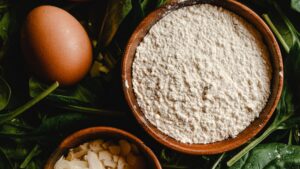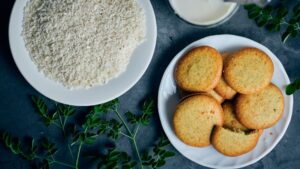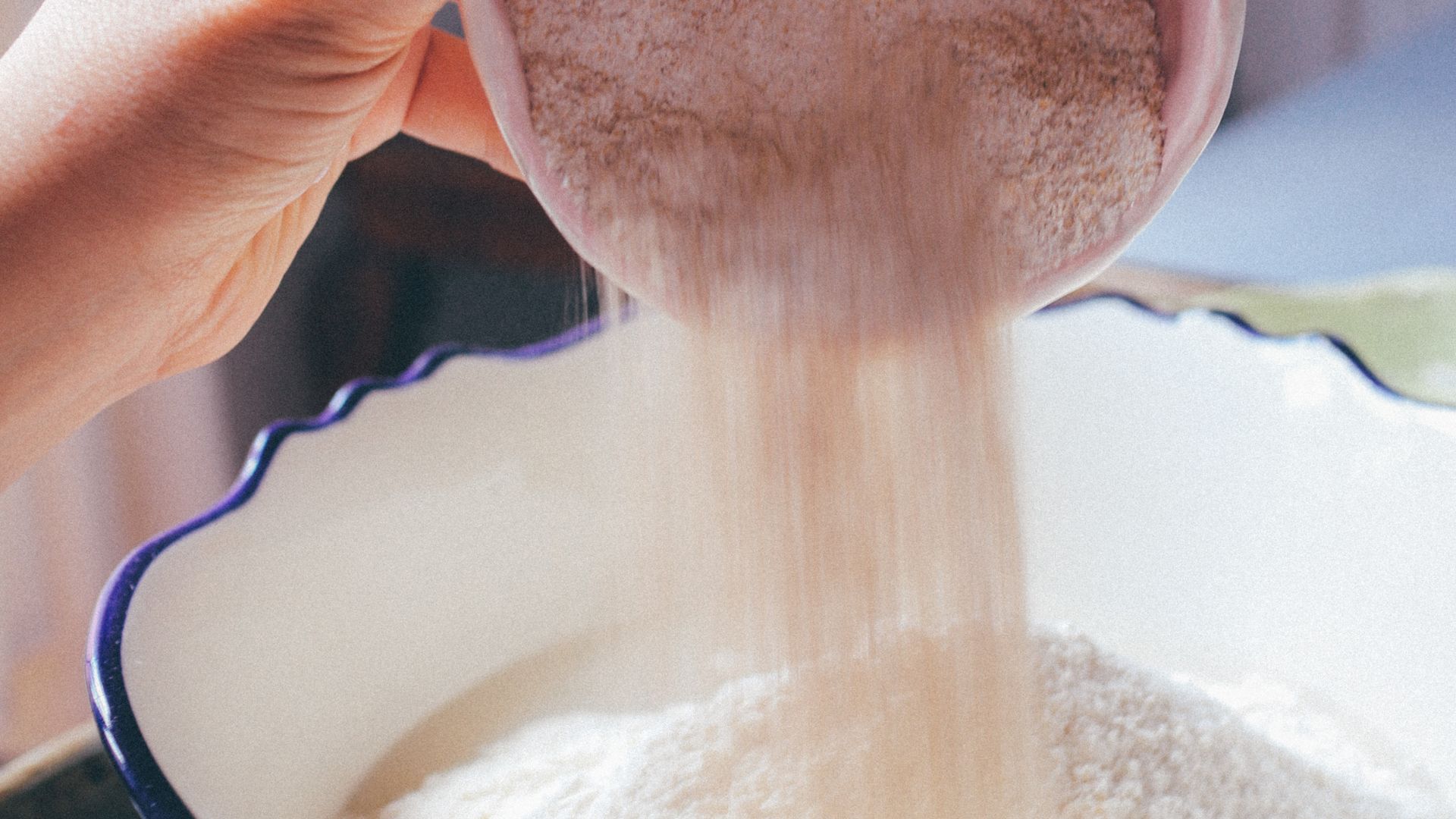In this topic, I’m going to talk about the magic of Cream of Rice Flour (CRF) and its role in cookie making. In my own personal experience, this ingredient has transformed my baking game, adding a unique texture and flavor to my cookies that I never knew was possible.
Table of Contents
ToggleWhat is Cream of Rice Flour (CRF)?
Cream of Rice Flour, or CRF, is a finely ground powder made from rice. It’s naturally gluten-free and has a soft, fine texture that makes it perfect for various culinary uses, including baking. Unlike regular rice flour, CRF has a smoother consistency, which helps in creating a more delicate and tender crumb in baked goods.== >> Check out the right Cream of Rice Flour, tools, and ingredients that you need here.

Why Use CRF in Cookie Making?
CRF plays several important roles in cookie making, each contributing to the final product’s quality and appeal. Here’s a breakdown of why you might want to consider incorporating CRF into your cookie recipes:== >> Check out the right Cream of Rice Flour, tools, and ingredients that you need here.
1. Texture Enhancer
One of the standout qualities of CRF is its ability to improve the texture of cookies. It provides a fine, smooth consistency that results in cookies with a tender crumb and a slightly crisp exterior. This makes every bite a delightful experience, with a melt-in-your-mouth feel that’s hard to achieve with other flours.== >> Check out the right Cream of Rice Flour, tools, and ingredients that you need here.
2. Gluten-Free Goodness
For those avoiding gluten, CRF is a fantastic alternative. It allows you to create cookies that are just as delicious and satisfying as their gluten-containing counterparts. Gluten-free baking can be challenging, but CRF simplifies the process by providing a reliable base that mimics the properties of wheat flour without the gluten.== >> Check out the right Cream of Rice Flour, tools, and ingredients that you need here.
3. Subtle Flavor Profile
CRF has a mild, neutral taste, making it an excellent base for cookies. It doesn’t overpower other ingredients, allowing the flavors of chocolate, vanilla, nuts, or whatever you choose to shine through. This subtlety makes it versatile and adaptable to a wide range of cookie recipes.== >> Check out the right Cream of Rice Flour, tools, and ingredients that you need here.

How to Use CRF in Your Cookie Recipes
Incorporating CRF into your cookie recipes is straightforward, but there are a few tips to ensure the best results:
1. Substitute Wisely
When using CRF as a substitute for regular flour, you might need to experiment with the ratios. A general rule is to start by replacing 25% of the all-purpose flour in your recipe with CRF. From there, you can adjust based on the texture and taste you’re aiming for.== >> Check out the right Cream of Rice Flour, tools, and ingredients that you need here.
2. Mix with Other Flours
For optimal results, consider blending CRF with other gluten-free flours like almond flour or tapioca flour. This mix can provide a balanced structure, helping your cookies hold together better while maintaining a desirable texture.== >> Check out the right Cream of Rice Flour, tools, and ingredients that you need here.
3. Adjust Liquids
Because CRF can absorb more moisture than wheat flour, you might need to adjust the liquid content in your recipe. Keep an eye on the dough’s consistency and add liquids gradually to achieve the perfect texture.== >> Check out the right Cream of Rice Flour, tools, and ingredients that you need here.

Delicious Cookie Recipes with CRF
To get you started, here are a couple of simple and tasty cookie recipes that use CRF:
1. Classic Chocolate Chip Cookies
- Ingredients: 1 cup CRF, 1 cup almond flour, 1/2 cup butter, 1/2 cup sugar, 1/2 cup brown sugar, 1 egg, 1 tsp vanilla extract, 1/2 tsp baking soda, 1/4 tsp salt, 1 cup chocolate chips.
- Instructions: Cream the butter and sugars together, then add the egg and vanilla. Mix in the dry ingredients until just combined, then fold in the chocolate chips. Bake at 350°F (175°C) for 10-12 minutes.== >> Check out the right Cream of Rice Flour, tools, and ingredients that you need here.
2. Lemon CRF Shortbread
- Ingredients: 1 cup CRF, 1/2 cup cornstarch, 1/2 cup powdered sugar, 1 cup butter, 1 tbsp lemon zest.
- Instructions: Cream the butter and sugar together, then add the lemon zest. Mix in the CRF and cornstarch until a dough forms. Shape into a log, chill, slice, and bake at 325°F (160°C) for 12-15 minutes.
CRF – Cream of Rice Flour – is a fantastic ingredient for cookie making, offering a unique blend of texture and subtle flavor. Its gluten-free nature makes it a versatile option for those with dietary restrictions, and its ability to enhance the texture of cookies makes it a must-try for any baking enthusiast.
More Examples of Using CRF in Cookie Recipes
Here are a few more examples of how you can incorporate CRF into your baking for amazing results.
3. Peanut Butter CRF Cookies
- Ingredients: 1 cup CRF, 1 cup peanut butter, 1/2 cup sugar, 1/2 cup brown sugar, 1 egg, 1 tsp vanilla extract, 1/2 tsp baking soda.
- Instructions: Preheat your oven to 350°F (175°C). Mix peanut butter, sugars, egg, and vanilla until smooth. Add CRF and baking soda, mixing until combined. Roll dough into balls and flatten with a fork. Bake for 8-10 minutes.
These cookies have a rich peanut butter flavor and a soft, crumbly texture that melts in your mouth. CRF enhances the cookie’s tenderness while maintaining its delightful peanut butter taste.== >> Check out the right Cream of Rice Flour, tools, and ingredients that you need here.
4. CRF Oatmeal Raisin Cookies
- Ingredients: 1 cup CRF, 1 cup oats, 1/2 cup butter, 1/2 cup sugar, 1/2 cup brown sugar, 1 egg, 1 tsp vanilla extract, 1/2 tsp cinnamon, 1/2 tsp baking soda, 1/4 tsp salt, 1 cup raisins.
- Instructions: Cream together the butter and sugars, then add the egg and vanilla. Stir in CRF, oats, cinnamon, baking soda, and salt until well combined. Fold in the raisins. Drop spoonfuls of dough onto a baking sheet and bake at 350°F (175°C) for 10-12 minutes.
The combination of CRF and oats gives these cookies a hearty, chewy texture with just the right amount of crispness around the edges. The raisins add a burst of sweetness, making these a perfect snack or dessert.== >> Check out the right Cream of Rice Flour, tools, and ingredients that you need here.
5. CRF Snickerdoodles
- Ingredients: 1 cup CRF, 1 cup all-purpose flour (or a gluten-free blend), 1/2 cup butter, 1 cup sugar, 1 egg, 1 tsp vanilla extract, 1/2 tsp cream of tartar, 1/2 tsp baking soda, 1/4 tsp salt, 1 tbsp cinnamon, 1/4 cup sugar (for rolling).
- Instructions: Preheat oven to 375°F (190°C). Cream the butter and sugar until light and fluffy, then beat in the egg and vanilla. In a separate bowl, mix CRF, flour, cream of tartar, baking soda, and salt. Gradually add to the wet ingredients. Combine 1/4 cup sugar and cinnamon in a small bowl. Roll dough into balls and coat with the cinnamon-sugar mixture. Place on a baking sheet and bake for 8-10 minutes.
These CRF snickerdoodles are soft and chewy on the inside with a crispy cinnamon-sugar exterior. The CRF gives them a light, tender crumb that pairs perfectly with their sweet and spicy coating.== >> Check out the right Cream of Rice Flour, tools, and ingredients that you need here.
Tips for Baking with CRF
To ensure your cookies turn out perfectly every time, keep these tips in mind:
- Measure Accurately: Use a kitchen scale to measure CRF for the most accurate results. This ensures the right texture and consistency in your cookies.
- Mix Thoroughly: Ensure the CRF is well combined with other dry ingredients to prevent clumping and ensure even distribution throughout the dough.
- Chill the Dough: For some recipes, chilling the dough can help improve the texture and prevent spreading. This is especially useful in recipes where CRF is the primary flour.== >> Check out the right Cream of Rice Flour, tools, and ingredients that you need here.
Drilling Deeper: Comparing CRF vs. Other Flours in Cookie Making
When it comes to cookie making, choosing the right flour can make all the difference. Let’s dive deeper and compare Cream of Rice Flour (CRF) with other commonly used flours to understand their unique benefits and how they affect your cookies.
CRF vs. All-Purpose Flour
Texture and Consistency: All-purpose flour is a staple in baking due to its balanced gluten content, providing structure and chewiness to cookies. CRF, on the other hand, is gluten-free and offers a finer, softer texture. Cookies made with CRF tend to have a more delicate crumb and are less chewy compared to those made with all-purpose flour.
Flavor Profile: All-purpose flour has a neutral flavor, allowing other ingredients to shine. CRF also has a mild flavor but with a slight nuttiness, which can add a subtle depth to your cookies without overpowering other flavors.
Dietary Considerations: For those avoiding gluten, CRF is a perfect substitute, ensuring that everyone can enjoy delicious cookies without sacrificing taste or texture.== >> Check out the right Cream of Rice Flour, tools, and ingredients that you need here.
CRF vs. Almond Flour
Texture and Consistency: Almond flour, made from ground almonds, has a coarser texture and provides a rich, moist crumb. It’s great for adding density and a slight crunch to cookies. CRF offers a smoother texture, resulting in a lighter, more tender cookie.
Flavor Profile: Almond flour brings a distinct nutty flavor that can enhance the overall taste of your cookies. CRF, with its neutral profile, allows for more versatility, especially in recipes where you want other flavors to stand out.
Nutritional Content: Almond flour is higher in fat and protein, making it more caloric but also more filling. CRF is lower in fat and protein, which might be preferable for those seeking lighter baked goods.== >> Check out the right Cream of Rice Flour, tools, and ingredients that you need here.
CRF vs. Oat Flour
Texture and Consistency: Oat flour, made from ground oats, gives cookies a hearty, chewy texture, often adding a bit of a rustic feel. CRF’s finer texture results in a smoother, more refined cookie. Combining both can yield a delightful balance of chewiness and tenderness.
Flavor Profile: Oat flour imparts a slightly sweet, earthy flavor, complementing ingredients like cinnamon, nuts, and dried fruits. CRF’s mild flavor makes it a versatile base, easily paired with a wide range of flavors without altering the overall taste profile significantly.
Health Benefits: Oat flour is rich in fiber and has a low glycemic index, making it a healthy choice for blood sugar control. CRF, while not as fiber-rich, is easier to digest and can be a good option for those with sensitive stomachs.== >> Check out the right Cream of Rice Flour, tools, and ingredients that you need here.
CRF vs. Coconut Flour
Texture and Consistency: Coconut flour is highly absorbent and can make cookies dense and dry if not used correctly. It often requires additional liquids and eggs to balance its texture. CRF provides a more straightforward substitution, yielding tender cookies without the need for major recipe adjustments.== >> Check out the right Cream of Rice Flour, tools, and ingredients that you need here.
Flavor Profile: Coconut flour has a pronounced coconut flavor, which can dominate the taste of your cookies. CRF’s neutral flavor allows the primary ingredients to shine through, making it suitable for a wider variety of recipes.
Nutritional Content: Coconut flour is high in fiber and low in carbs, suitable for keto and low-carb diets. CRF offers a more balanced nutritional profile, suitable for those looking for a moderate carbohydrate intake.== >> Check out the right Cream of Rice Flour, tools, and ingredients that you need here.
Choose the Right Flour for Your Cookies
Selecting the right flour depends on the texture, flavor, and nutritional goals you have for your cookies. Cream of Rice Flour (CRF) stands out for its gluten-free properties, fine texture, and mild flavor, making it a versatile choice for many cookie recipes. Whether you’re looking to make a classic chocolate chip cookie, a delicate shortbread, or something more unique, CRF can be a valuable addition to your baking arsenal.
Comparison table of Cream of Rice Flour (CRF) vs. Other Flours in Cookie Making
| Aspect | Cream of Rice Flour (CRF) | All-Purpose Flour | Almond Flour | Oat Flour | Coconut Flour |
|---|---|---|---|---|---|
| Texture and Consistency | Fine, smooth, and tender texture | Balanced gluten, chewy texture | Coarse, moist, and dense crumb | Hearty and chewy | Highly absorbent, can be dense and dry |
| Flavor Profile | Mild, neutral, slight nuttiness | Neutral | Distinct nutty flavor | Slightly sweet and earthy | Pronounced coconut flavor |
| Dietary Considerations | Gluten-free | Contains gluten | Gluten-free, higher in calories | Gluten-free, high fiber | Gluten-free, low carb, high fiber |
| Nutritional Content | Moderate carbohydrate content | Standard carbohydrate content | High in fat and protein | Rich in fiber, low glycemic index | High in fiber, low in carbs |
| Best Uses | Versatile, suitable for many cookie recipes | Traditional baking | Rich and dense cookies | Rustic, hearty cookies | Keto and low-carb cookies |
Key Notes and Considerations
- Texture and Consistency:
- CRF provides a smooth and tender texture, ideal for delicate cookies.
- All-Purpose Flour offers a balanced texture with good structure due to its gluten content.
- Almond Flour gives a dense and moist crumb, perfect for rich cookies.
- Oat Flour creates a hearty, chewy texture, adding a rustic feel.
- Coconut Flour is highly absorbent and can make cookies dense and dry without proper adjustments.
- Flavor Profile:
- CRF has a mild flavor, making it versatile for various recipes.
- All-Purpose Flour is neutral, allowing other ingredients to shine.
- Almond Flour adds a distinct nutty flavor.
- Oat Flour imparts a slightly sweet, earthy taste.
- Coconut Flour has a strong coconut flavor, which can dominate the cookie’s taste.
- Dietary Considerations:
- CRF is naturally gluten-free, suitable for those with gluten intolerance or celiac disease.
- All-Purpose Flour contains gluten, not suitable for gluten-free diets.
- Almond Flour is gluten-free and nutrient-dense, but higher in calories.
- Oat Flour is gluten-free and rich in fiber, beneficial for blood sugar control.
- Coconut Flour is low in carbs and high in fiber, fitting for keto and low-carb diets.
- Nutritional Content:
- CRF offers a balanced nutritional profile, moderate in carbohydrates.
- All-Purpose Flour is standard in carbs and protein, providing energy and structure.
- Almond Flour is high in healthy fats and protein, contributing to satiety.
- Oat Flour is rich in fiber and has a low glycemic index, promoting digestive health.
- Coconut Flour is high in fiber and low in carbs, supporting low-carb dietary plans.
- Best Uses:
- CRF is versatile and can be used in many cookie recipes, providing a tender crumb.
- All-Purpose Flour is the go-to for traditional baking, offering reliability and structure.
- Almond Flour is excellent for rich, dense cookies with a moist texture.
- Oat Flour works well in rustic, hearty cookies with a chewy texture.
- Coconut Flour is ideal for keto and low-carb cookies, though it requires careful handling due to its absorbency.
FAQs on Cream of Rice Flour in Cookie Making
Q1: What is Cream of Rice Flour (CRF)?
CRF is a finely ground powder made from rice, known for its smooth texture and mild flavor. It’s naturally gluten-free, making it a great alternative for those with gluten sensitivities.
Q2: How does CRF affect the texture of cookies?
CRF gives cookies a tender, delicate crumb and a slightly crisp exterior. Its fine consistency helps create a smoother texture compared to other flours.
Q3: Can I substitute CRF for all-purpose flour in any cookie recipe?
Yes, but it’s best to start by replacing 25% of the all-purpose flour with CRF and adjust from there. CRF absorbs more moisture, so you might need to tweak the liquid content in your recipe.
Q4: Is CRF suitable for gluten-free baking?
Absolutely! CRF is a great option for gluten-free baking, providing structure and texture without the gluten.
Q5: How does CRF compare to almond flour?
CRF has a finer texture and a more neutral flavor compared to almond flour, which is coarser and has a distinct nutty taste. Almond flour also adds more moisture and density to cookies.
Q6: What are the nutritional benefits of CRF?
CRF is moderate in carbohydrates and lower in fat and protein compared to almond flour. It’s easier to digest and can be a good option for those with sensitive stomachs.
Q7: Can I use CRF in combination with other flours?
Yes, blending CRF with other gluten-free flours like almond or oat flour can yield great results, balancing structure and texture.
Q8: Where can I buy CRF?
CRF can be found in most grocery stores, health food stores, or online retailers. Look for it in the gluten-free or baking aisle.
Q9: Are there any specific tips for baking with CRF?
Ensure accurate measurement, thorough mixing to avoid clumping, and consider chilling the dough for better texture. Adjust liquid content as needed to achieve the desired dough consistency.
Q10: What types of cookies work best with CRF?
CRF is versatile and works well in a variety of cookies, including chocolate chip, shortbread, snickerdoodles, and more. Its neutral flavor complements many ingredients, making it a flexible choice.== >> Check out the right Cream of Rice Flour, tools, and ingredients that you need here.
Final Words
Cream of Rice Flour (CRF) is a fantastic ingredient to explore in your cookie-making adventures. Its fine texture, mild flavor, and gluten-free properties make it a valuable addition to your pantry. Whether you’re looking to create delicate, tender cookies or need a gluten-free alternative, CRF offers versatility and delicious results.
By understanding how CRF compares to other flours and knowing how to use it effectively, you can elevate your baking game and enjoy a wide range of delightful cookies. So, don’t hesitate to experiment with CRF in your next batch of cookies and experience the unique benefits it brings to your recipes.
Related Posts
- GI: Ginger role in cookie making Explained
In this blog post, I’m going to talk about ginger,…
- RS: Raisin Syrup role in cookie making Explained
In this blog, I'm talking about Raisin Syrup (RS) and…
- KT: Kiwi Tart role in cookie making Explained
In this topic, I'm going to talk about Kiwi Tart,…
- MR: Maple Rum role in cookie making Explained
In this topic, I’m going to talk about MR –…
- HA: Hazelnuts role in cookie making Explained
In this blog, I’m going to talk about hazelnuts and…
- PC: Peanut Chips role in cookie making Explained
In this topic, I’m going to talk about peanut chips,…
- BL: Blueberry role in cookie making Explained
When it comes to adding a burst of flavor and…
- CO: Coconut Oil role in cookie making Explained
In this blog post, I’m diving into the delightful world…
- GB: Gluten-Free Blend role in cookie making Explained
In this blog, I’ll talk about my journey with gluten-free…
- CU: Cocoa Butter role in cookie making Explained
In this topic, I’m going to talk about cocoa butter…
- PLT: Plant-Based Milk role in cookie making Explained
In this blog post, I’m diving into the fascinating world…
- SB: Sea Salt role in cookie making Explained
When it comes to baking cookies, there’s more to consider…
- DF: Dairy-Free role in cookie making Explained
In this blog, I’m going to talk about dairy-free ingredients…
- BF: Buttermilk Powder role in cookie making Explained
When it comes to baking cookies, every ingredient plays a…
- DS: Dates role in cookie making Explained
When it comes to baking cookies, I've always been fascinated…

